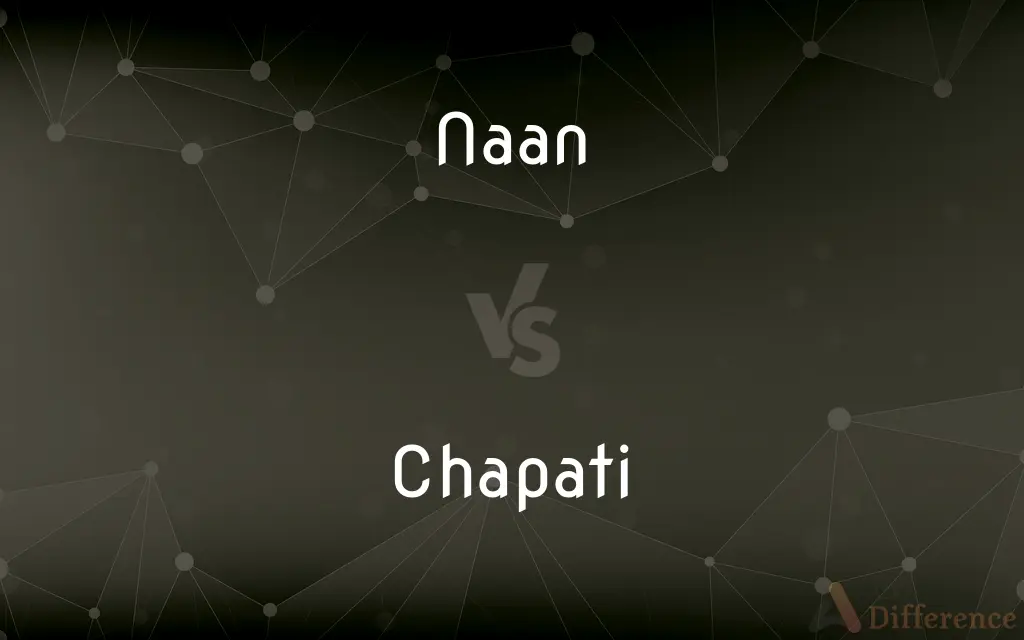Naan vs. Chapati — What's the Difference?
By Fiza Rafique & Maham Liaqat — Updated on April 4, 2024
Naan is a leavened, soft bread traditionally baked in a tandoor, known for its fluffy texture, while chapati is an unleavened, flatbread, cooked on a griddle, characterized by its simplicity and whole wheat flour.

Difference Between Naan and Chapati
Table of Contents
ADVERTISEMENT
Key Differences
Naan is a type of bread that requires yeast or another leavening agent, resulting in a soft and fluffy texture. It's often prepared in a tandoor (a clay oven), which gives it a distinctive taste and texture. While chapati, also known as roti, is made from whole wheat flour and water, kneaded into dough, rolled out into thin circles, and cooked on a griddle without any leavening agents, making it more straightforward and quicker to prepare.
The ingredients of naan often include all-purpose flour, yeast, yogurt, and sometimes milk or eggs, contributing to its rich flavor and soft texture. On the other hand, chapati is typically made with just whole wheat flour and water, occasionally with a small amount of oil, emphasizing its simplicity and healthfulness.
Naan is traditionally served with richer, more robust curries or dishes, acting as a scoop or a spoon to sop up sauces and gravies. Chapati, being a staple in daily meals across many parts of South Asia, is used similarly but is preferred for its versatility and lighter complement to both light and heavy dishes.
The cooking method for naan involves slapping it onto the side of a tandoor oven, where it bakes quickly at high temperatures, acquiring a smoky flavor. Chapati is cooked on a flat griddle, known as a tava, and is often finished over an open flame, puffing up into a light and airy bread.
Both naan and chapati play integral roles in their respective culinary traditions, offering different textures, flavors, and methods of preparation. While naan may be seen as a special or more indulgent option due to its richer ingredients and complex flavors, chapati is valued for its everyday simplicity and healthful qualities.
ADVERTISEMENT
Comparison Chart
Flour Type
All-purpose (sometimes with added eggs or milk)
Whole wheat
Leavening Agent
Yeast or baking powder
None
Cooking Method
Baked in a tandoor
Cooked on a griddle (tava)
Texture
Soft, fluffy
Soft, but more dense and chewy
Flavor
Rich, sometimes buttery or garlicky
Mild, wheaty
Common Servings
With rich curries or dishes
Daily meals, with a variety of dishes
Preparation Time
Longer due to leavening
Shorter, as no leavening is required
Health Aspect
Generally more caloric
Considered healthier due to whole grains
Compare with Definitions
Naan
A leavened, soft bread baked in a tandoor.
She spread garlic butter over the naan for extra flavor.
Chapati
A staple in daily meals across South Asia.
Chapati is often eaten with lentils and vegetables.
Naan
Known for its fluffy, chewy texture.
The naan from the tandoor had a perfect, fluffy texture.
Chapati
Has a mild, wheaty flavor and chewy texture.
The freshly cooked chapati had a delicious, earthy taste.
Naan
Traditionally served with rich, spicy dishes.
For dinner, they had chicken tikka masala with naan.
Chapati
Made with whole wheat flour, water, and sometimes oil.
He added a bit of oil to the chapati dough for softness.
Naan
Requires yeast or baking powder for leavening.
The dough for naan had yeast, making it rise beautifully.
Chapati
Healthier due to the use of whole grains.
Choosing chapati over white bread is a healthier option.
Naan
Often contains dairy products for richness.
Milk in the naan dough adds to its softness.
Chapati
An unleavened flatbread cooked on a griddle.
She made fresh chapati for the meal.
Naan
Naan (Persian: نان, romanized: nān, Pashto : نان Dari: نان, Punjabi: ਨਾਨ, Hindi: नान, Bengali: নান) is a leavened, oven-baked flatbread found in the cuisines mainly of Western Asia, Indian subcontinent, Indonesia, Myanmar and the Caribbean.
Chapati
Chapati (alternatively spelled chapatti, chappati, chapathi, or chappathi; pronounced as IAST: capātī, capāṭī, cāpāṭi), also known as roti, rotli, safati, shabaati, phulka and (in the Maldives) roshi, is an unleavened flatbread originating from the Indian subcontinent and staple in India, Nepal, Bangladesh, Pakistan, Sri Lanka, East Africa, Arabian Peninsula and the Caribbean. Chapatis are made of whole-wheat flour known as atta, mixed into dough with water, oil and optional salt in a mixing utensil called a parat, and are cooked on a tava (flat skillet).It is a common staple in the Indian subcontinent as well as amongst expatriates from the Indian subcontinent throughout the world.
Naan
A flat, leavened bread of northwest India, made of wheat flour and baked in a tandoor.
Chapati
A flat, unleavened, disk-shaped bread of northern India, made of wheat flour, water, and salt. Also called roti.
Naan
A type of round, flat bread baked in a tandoor popular in South and Central Asian cuisine.
Chapati
A flat, unleavened bread from northern India and Pakistan.
Chapati
A flat pancakelike bread cooked on a griddle, originating in India.
Chapati
Flat pancake-like bread cooked on a griddle
Common Curiosities
Can chapati be used as a wrap?
Yes, chapati is flexible and can be used as a wrap for meats, vegetables, or other fillings.
Is chapati healthier than naan?
Generally, yes, because chapati is made from whole wheat flour and has fewer calories and less fat.
What dishes pair well with chapati?
Chapati pairs well with a variety of dishes, including vegetarian curries, dal (lentil soup), and cooked vegetables.
Why does chapati sometimes puff up while cooking?
The heat causes steam to form inside the dough, making it puff up if it's rolled evenly and no tears are present.
What's the main difference between naan and chapati?
Naan is leavened and cooked in a tandoor, resulting in a soft, fluffy texture, while chapati is unleavened, cooked on a griddle, and has a denser texture.
Can leftover naan and chapati be reheated?
Yes, both can be lightly reheated on a skillet or in the microwave, though fresh is usually best for taste and texture.
Do naan and chapati require any special ingredients?
Naan may require yogurt, milk, or eggs, which are not typically used in chapati.
Can naan be made without a tandoor?
Yes, naan can be cooked in an oven or on a skillet, though the flavor will be slightly different from traditional tandoor-cooked naan.
Why is naan more flavorful than chapati?
Naan often contains ingredients like yogurt, milk, or eggs, and is sometimes topped with garlic or butter, adding to its flavor profile.
How long does it take to prepare naan?
Preparation time for naan is longer due to the need for the dough to rise, typically taking a few hours including resting time.
Can naan and chapati dough be prepared in advance?
Yes, both doughs can be made in advance and refrigerated, though naan dough should be allowed to rise before storage.
Is it possible to make gluten-free naan and chapati?
Yes, by substituting the regular flour with gluten-free flour blends, though the texture and taste may vary.
Are naan and chapati eaten at specific meals?
Naan is often served with dinner or as part of a special meal, while chapati is consumed at any meal due to its versatility.
Is butter or oil necessary for making chapati?
Not necessary, but a small amount of oil can be added to the dough to improve the softness and pliability of the chapati.
How do you store leftover naan and chapati?
Both should be stored in airtight containers and can be kept at room temperature for a short time or refrigerated for longer freshness.
Share Your Discovery

Previous Comparison
Campaign vs. Drive
Next Comparison
Trailer vs. TrolleyAuthor Spotlight
Written by
Fiza RafiqueFiza Rafique is a skilled content writer at AskDifference.com, where she meticulously refines and enhances written pieces. Drawing from her vast editorial expertise, Fiza ensures clarity, accuracy, and precision in every article. Passionate about language, she continually seeks to elevate the quality of content for readers worldwide.
Co-written by
Maham Liaqat













































